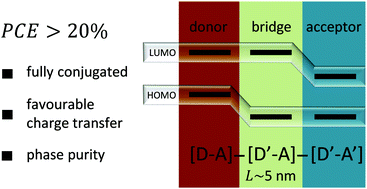Design principles for block polymer organic double heterojunction solar cells†
Abstract
An organic double heterojunction photovoltaic device is described and the limits of its power conversion efficiency are investigated via numerical calculations. In the absence of exciton binding energy, fully conjugated block polymer devices exhibit power conversion efficiencies slightly exceeding the Shockley–Queisser limit. As exciton binding energy increases, a decrease in efficiency occurs, but remains over 20% for binding energies less than 0.5 eV. Further calculations show that devices require a high degree of phase purity to leverage the full benefit of the double heterojunction structure. Synthetic targets are identified and their maximum efficiency is calculated based on experimentally measured energy levels, leading to a generalized structural motif.


 Please wait while we load your content...
Please wait while we load your content...